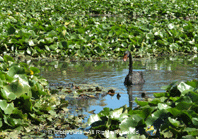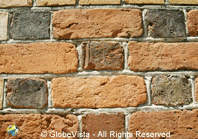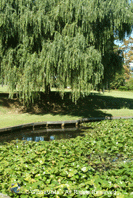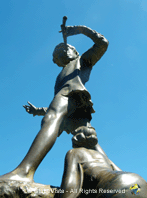The Pits

Queens Gardens is located on the corner of Hay and Plain Streets, East Perth . The original site of Queens Gardens was used by colonists for duck hunting and horse racing. However, it was soon discovered that the clay deposits on the site were suitable for brick making. By the mid 1800s the site had become a brickworks where the clay was mined and then used for the production of bricks. The first person to make bricks on the land was Mr Henry Crane. Mr Crane was the father-in-law of Harry Stitchborn, who was the curator of the East Perth Cemeteries from the 1850s-1880s.The early handmade bricks were called sand stocks because fine grains of sand had to be sprinkled inside the brick molds to stop the bricks from sticking. During the early 1870’s there were three brick yards operating on the site, they were owned and operated by Charles Howlett, Thomas Smith and James Brittain (1882-1897). The site became known as Brickfields Reserve. The bricks which were made from the reserve were used to construct several prominent buildings in Perth such as the Barracks Arch, Town Hall and St George’s Cathedral.
In the early days making handmade brick was a slow, old process (especially in winter). It was made even harder by the absence of drying sheds. During the rainy season work virtually came to a standstill. At night the bricks were fired and the men had to stay up all night to keep the fires going. In J.E. Hammonds’s memoirs, he recalls one of the clay holes being dug much deeper than the others in order to discard beer bottles discovered at the works. Drinking was strictly prohibited but employees often drank the ale late at night as they manned the fires. Evidence was often  discarded at the bottom of this clay pit by the workers to avoid getting caught. Mosquitoes were a nightmare for workers and were particularly bad due to the swampy conditions and the dense thicket known as “woolly brush”. The thickets were the mossies breeding grounds and most of the brick makers were forced to wear veils to protect themselves from the bloodsuckers. The rushes around the swamps were also popular for candle making. The bark was stripped to the core and then the core was dried (by the fire) before being dipped in hot fat. Once the fat covered core was cooled off, it was dipped over and over again until it became thick enough to be a candle.
discarded at the bottom of this clay pit by the workers to avoid getting caught. Mosquitoes were a nightmare for workers and were particularly bad due to the swampy conditions and the dense thicket known as “woolly brush”. The thickets were the mossies breeding grounds and most of the brick makers were forced to wear veils to protect themselves from the bloodsuckers. The rushes around the swamps were also popular for candle making. The bark was stripped to the core and then the core was dried (by the fire) before being dipped in hot fat. Once the fat covered core was cooled off, it was dipped over and over again until it became thick enough to be a candle.
Around the 1890s brick extraction became difficult and the pits and kilns were abandoned. The City of Perth filled in the clay pits and fenced the area off.
The Gardens
In 1894 a decision was made to have the abandoned reserve developed into public gardens. The project was under the direction of Sydney gardener and landscaper Mr A.W.Farris and Perth’s head gardener John Braithwaite.

The brick kilns were removed and the clay pits were transformed into the beautiful ponds you see today. The site was renamed East Perth Park and then changed once more to Queens Gardens in honour of Queen Victoria. The park was officially opened in October 1899 by the Lord Mayor Alexander Forrest. It soon became a popular place for Perth’s elite, who would often host afternoon tea parties by the lakes.
Today the gardens attract an abundance of birdlife such as the Black Swans, Willy Wagtails, and the occasional stork. Along with the birdlife is a spectacular array of dragonflies that play amongst the water-lilies.
The Fairytale
In 1927 the Peter Pan statue was presented to the children of Western Australia by the members and friends of the Rotary Club of Perth. The statue is a replica of Sir George Frampton’s famous Peter Pan statue which is located in London’s Kensington Gardens in England and is one of only four made from the original mold.

Based on J.M. Barrie’s immortal character, Peter Pan, the base of the statue is signed by the author and not the sculptor, Sir George Frampton, which probably seems apt as the gardens seem like Never Never Land on the outer edge of the Central Business District of Perth.
